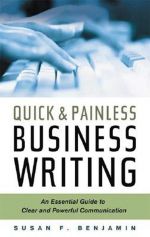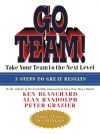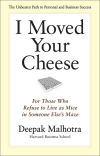Правообладателям!
Представленный фрагмент книги размещен по согласованию с распространителем легального контента ООО "ЛитРес" (не более 20% исходного текста). Если вы считаете, что размещение материала нарушает ваши или чьи-либо права, то сообщите нам об этом.Читателям!
Оплатили, но не знаете что делать дальше?
Текст бизнес-книги "Quick & Painless Business Writing: An Essential Guide to Clear and Powerful Communication"
Автор книги: Susan Benjamin
Раздел: Зарубежная деловая литература, Бизнес-книги
Возрастные ограничения: +12
Текущая страница: 1 (всего у книги 1 страниц)
Susan F. Benjamin
Quick & Painless Business Writing: An Essential Guide to Clear and Powerful Communication
Dedication
To Dan and Adam, the smartest, funniest guys I know. Thanks for helping me tap the energy and humor in my own voice.
Acknowledgments
Writing a book is never easy. Okay, actually, writing this book was easy, but who wants to start an acknowledgment page that way? So, I want to acknowledge not the people who helped me trudge through the misery of the writing process, but those who made it possible for me to write – and delight in – this book.
First, my agent. Let me tell you, every good writer (and every bad writer for that matter) needs a good agent. And Grace Freedson’s the best. She’s available, interested, and willing to drink a glass of wine with her author even when better judgment tells her not to. More than an agent, she’s a dream-maker and friend.
But even with a great agent, you still need content. That’s where my clients come in. So big thanks to the National Geospatial Intelligence Agency University, The Missile Defense Agency, The Office of Personal Management, Fleishman-Hillard, The Carnegie
Mellon Executive Program, and, of course, Liberty Mutual Group, among others. Every seminar I taught and project I worked on was its own learning experience.
Special thanks to everyone in the Plain Language Initiative under Clinton-Gore: Annetta Cheek, Bill Foster, Kate Blunt, and many others; and to those who trusted me to research language strategies, conduct focus groups, and unearth something new: Ellen Tunstall, Janice Seimsen, and Steve Sullivan. Many of the lessons I learned in overseeing these projects are in this book.
Also big thanks to Rick Frishman for his referrals and advice, Josh Stellar for the emergency care on my computer just before deadline, and my proofer Libby Howard – ever ready with a correction and a joke – who doubtless has read and corrected this very line.
Of course, fortifying the writer’s life are all the people who say things like: “How’s the book going?” which I take as encouragement, and “Don’t worry, I’ll take your son for the afternoon while you work.” In particular, Kathryn Stellar, Lissa and Garth Jansen, Rose McKee, and at the old home front, Margie Green and Susan Erony for their goodwill and good wishes. And finally, thanks to Kitty Clark, modern dance teacher, for showing me my body can do more than sit in front of a keyboard.
The Quick, Painless, and Indispensable
Introduction
Why Quick and Painless?
The Six Golden Rules of Writing: Read, read, read and write, write, write.
– Ernest Gains
So why “Quick and Painless” business writing? Better to ask why not. Granted, you’d probably prefer drinking a Bloody Mary on a Sunday afternoon than writing a report in your cubicle – or sunny home office for that matter – but all things considered, writing isn’t the worst (or hardest) job in the world. In fact, you might actually enjoy it. Plenty of people do.
To get there, though, you need to extricate all that hurts and slows you down. You see, throughout your life, you’ve been overdosing on advice, ranging from practical (but distracting) to maddening, about the written word. Lessons from even your most beloved teachers probably included too many rules to possibly remember, including when to use “I” or “me,” “may” or “can,” and why certain words – even those words that felt as comfortable as in worn-in sneakers – were taboo.
To get perspective, you probably turned to books about writing. And there are LOTS to choose from. Frankly, I wish I’d written some of them, especially Strunk and White’s classic, The Elements of Style. It sold a gazillion copies and reads like a good novel – an interesting, light style. And yes, many of those books do contain useful information.
There’s only one problem: None of those how-tos can really help you write. They can give you guidance, sure, but how about a sense of voice? Or direction for how to best heal your writing ills and maximize your strengths? Think about writing as an athletic event and you know what I mean. Did Tiger Woods learn to play golf from a manual? Did Mohammad Ali become a great boxer by memorizing rules? No – they figured out how to work from their natural abilities. To overcome obstacles. And to adapt their style, depending on the environment, the opposition, and what they hoped to achieve.
So, before you turn the pages of Quick and Painless Business Writing, read the following adages. They’ll help you maximize the information that follows – some of it reminiscent of lessons past, and much of it entirely new. And do the exercises that you’ll find in every chapter. They won’t take long and will help you experience immediate results. In the process, you’ll find writing isn’t just quick and painless – it’s quick and satisfying.
Pre-nitty-gritty Adages
Take a one-step-at-a-time approach. As we go through each of these chapters, from nouns to cohesive structure, check your writing. How does it measure up? Are you strong in one particular area? If so, keep it up. If not, identify that problem – be it wordiness, sentence structure foibles, or anemic verbs. Then, focus on correcting that problem every time you write until you overcome it. Then move on to the next requirement. And give yourself a hand: You learned something and got your money’s worth from this book.
Think strategy. Sure, follow the rules of writing, the ones you learned in high school, college, and business-writing classes…unless they seem impractical, outdated, or unnecessary. Then, think strategy. Think your sentence sounds more natural with a pre-position at the end? Go ahead, if the situation’s informal and your reader won’t object. Want to tell a joke? If you’re drafting regulations, better not. But if you’re writing marketing material or an e-mail to a close colleague, all the better.
Get help. Lots of help. Professional writers, including New York Times journalists and Pulitzer Prize-winning novelists, have a squad of professionals giving feedback on all they write. As for me, I have an editor, agent, book coach, proofreader, and assorted content experts full of ample supplies of feedback. Usually, they comment on my genius and offer heaps of praise. I’m kidding; I’ve experienced waves of negatives. When they’re constructive, I wallow in them a while, and then do what they suggest. When they’re uselessly critical, I swim right past them. It’s either that or drown.
So, get help, only get the right help. Here are some people to depend on:
Peer editors. These coworkers can review your material – and hopefully you’ll review theirs. As with any good relationship, you and your peers should have different strengths and weaknesses. Have problems with sentence structure? Then find someone who has mastered this aspect of writing, but is weak in areas where you excel. Then, give him or her feedback in return.
Your manager. Managers can be iffy. Some have great insights, while others remain stuck in archaic styles of writing. Besides, they decide whether you’ll get a raise, a promotion, or a transfer. So do you really want to appear vulnerable? If your manager gives you feedback anyway, learn more. What are the reasons for the changes he or she suggested? And what negative patterns can the two of you find and avoid in the future?
Professional trainers and coaches. You may find great sources of feedback through training centers at your company or through adult education programs. The instructors will work with you in one-on-one sessions and provide confidential and invaluable insights. Call around and find out where and when. And don’t forget to contact the English department at your local college. Graduate students, and even some professors, are usually willing to help for a manageable fee.
Read. Every day. It’s imperative. Consciously or not, you imitate the styles of the documents you read. No matter how many writing classes you take or writing workbooks you open, you still need to read. You don’t have to read highbrow literature: in fact, you don’t want to read highbrow literature. It will slow down your style. Instead, read what you enjoy. Here are some ideas:
Read newspapers and magazines. Amazingly, according to Journalism.orgJournalism.orgJournalism.org’s annual State of the News Media report in 2004, only slightly more than half the population reads hardcopy newspapers, yet newspapers offer up some of the best writing around. It’s usually fast and interesting – just the way you like it. Want to read The Wall Street Journal? Go ahead. But don’t feel embarrassed if you prefer to indulge in your local tabloid. Regardless, an article over coffee in the morning will fortify your style for the day.
Read books. I know this sounds obvious, but many people don’t read them. In fact, the average American only reads one book a year – usually in summer for some “sea ’n’ sun” entertainment. Yet they’re the greatest influence imaginable on your writing. You stay immersed in the book’s language for a long time, relaxing and enjoying the experience, much like soaking in a hot tub. You’ll flow from chapter to chapter, witnessing how the author’s ideas come together. As for the (in)famous literary novels? As I said, don’t reach for Russian tragedies if your heart craves true romance.
Read workplace documents with caution. Yes, you have to read workplace documents. But beware: read these and nothing else, and you unconsciously start duplicating the style. Depending on the document, it may be as interesting and provocative as the ingredients on a can of paint.
Remember the fun factor. So we’ve established that most people don’t read for pleasure. But why? My guess is people read for the wrong reasons. Most think books are good for them. Books will make them better people, somehow. Stronger people. Healthier people. Reasons why you might, say, eat green, leafy vegetables. That’s true, of course, books are good for you. The real reasons to read and keep on reading, though: it’s fun, lasts far longer than a movie, and is more intensive than Web surfing. Oh – and books and magazines are easier to carry around than a television set.
Practice makes perfect. With writing, as with sports, you only improve by doing. And doing. And doing. And getting better as you go. So while cruising through this workbook you’ll see suggested exercises. They’re marked “Q&P Break.” Stop, go to the computer, and go ahead. Don’t worry – these exercises won’t take hours each. In fact, they work similar to the drip method of irrigation: By doing small amounts every day, your style will be fresh and fertile. Many have a high usability factor, too, meaning you can actually write and rewrite copy for work.
Anything else?
You’ll learn lots of things formally and informally as we go along, such as how to place words strategically, to maximize the power of your message, and the optimal approach to using sentence rhythms. You’ll even learn to read other people’s documents differently – especially when their message is unclear or poorly written.
So sit back, relax, grab a drink and a pen and paper, and let’s get started.
Section I
Why Quick? Why Painless? Why Not?
Chapter 1
Five No-Worry Reality Checks
Reality Check #1: The ResponseLet’s start with the Mother of All Reality Checks – the ultimate reason you write at work. But first, answer this question: Why write at work? Don’t think about your answer – just respond from your gut. A few words will do. Ready? What’s your answer?
If you’re like most of the tens of thousands of people I’ve trained over the years, it probably was: “To communicate,” or “To send information,” or something like that. Actually, writing to communicate is the job of newspapers and magazines. People read them to get information, pass the time, sip a Mimosa on a Sunday morning, and flip through the pages of the Sunday edition.
In the business world, you write to get a response. Writing a proposal? You want the reader to sign on the dotted line. Sending an e-mail asking for material? You want the material, but that’s not all. You want the material now, today, right away. Not, say, after two or three phone calls or follow-up e-mails. Writing a job announcement? Sure, you want people to apply. But you want the right people to apply, and send you the right information when they do. That means, of course, you don’t want the wrong people to apply and have to sift through endless incorrect applications. You know the drill.
The importance of getting the right response is no small matter. In fact, it affects just about everything in your business. Let’s look at that e-mail I mentioned a moment ago. Here’s how it goes:
Hypothetical e-mail scenario: You’re writing a report. Since this is hypothetical, I’m tempted to say the report was for a client and included recommendations that would help them immeasurably and bring you a $2.2 million contract. But your e-mail is probably the more run-of-the-mill variety, such as you and your team are writing a report to help your boss determine the next steps for a project and you need information from another department.
What happened: You sent the e-mail telling your associate in that other department about the project, what you needed, why, and when.
What happened next: Nothing. So you e-mailed again.
And then? Nothing. Still nothing. So you called to remind them.
And: They still didn’t respond, so you found someone else to send the e-mail. Or: They did respond, but you didn’t get everything you wanted. Or: They did respond, only it was late. Or…lots of other possibilities.
Naturally, the cost of this delay adds up. There’s your time spent in e-mailing and calling the person. Then, there’s the time of others on your team who can’t move forward with their contribution to the report until they have the missing information. And at long last, there’s the valuable time of that back-up person you contact since the original (still!) didn’t respond. Plus the stop-and-go time of delaying various aspects of the report and the project, which is on hold since your boss didn’t get the report…Now, multiply this by 10 or even 20 unopened or unanswered e-mails and…well…you know where I’m going.
Конец ознакомительного фрагмента.
Текст предоставлен ООО «ЛитРес».
Прочитайте эту книгу целиком, купив полную легальную версию на ЛитРес.
Безопасно оплатить книгу можно банковской картой Visa, MasterCard, Maestro, со счета мобильного телефона, с платежного терминала, в салоне МТС или Связной, через PayPal, WebMoney, Яндекс.Деньги, QIWI Кошелек, бонусными картами или другим удобным Вам способом.
Внимание! Это ознакомительный фрагмент книги.
Если начало книги вам понравилось, то полную версию можно приобрести у нашего партнёра - распространителя легального контента ООО "ЛитРес".Правообладателям!
Представленный фрагмент книги размещен по согласованию с распространителем легального контента ООО "ЛитРес" (не более 20% исходного текста). Если вы считаете, что размещение материала нарушает ваши или чьи-либо права, то сообщите нам об этом.Читателям!
Оплатили, но не знаете что делать дальше?







